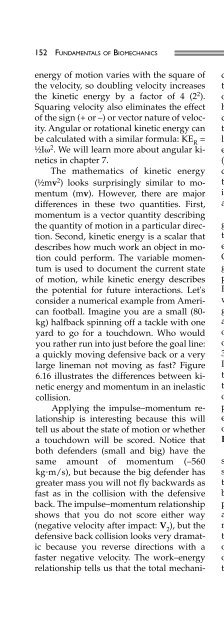Fundamentals of Biomechanics
Fundamentals of Biomechanics
Fundamentals of Biomechanics
Create successful ePaper yourself
Turn your PDF publications into a flip-book with our unique Google optimized e-Paper software.
152 FUNDAMENTALS OF BIOMECHANICS<br />
energy <strong>of</strong> motion varies with the square <strong>of</strong><br />
the velocity, so doubling velocity increases<br />
the kinetic energy by a factor <strong>of</strong> 4 (2 2 ).<br />
Squaring velocity also eliminates the effect<br />
<strong>of</strong> the sign (+ or –) or vector nature <strong>of</strong> velocity.<br />
Angular or rotational kinetic energy can<br />
be calculated with a similar formula: KE R =<br />
½I 2 . We will learn more about angular kinetics<br />
in chapter 7.<br />
The mathematics <strong>of</strong> kinetic energy<br />
(½mv 2 ) looks surprisingly similar to momentum<br />
(mv). However, there are major<br />
differences in these two quantities. First,<br />
momentum is a vector quantity describing<br />
the quantity <strong>of</strong> motion in a particular direction.<br />
Second, kinetic energy is a scalar that<br />
describes how much work an object in motion<br />
could perform. The variable momentum<br />
is used to document the current state<br />
<strong>of</strong> motion, while kinetic energy describes<br />
the potential for future interactions. Let's<br />
consider a numerical example from American<br />
football. Imagine you are a small (80kg)<br />
halfback spinning <strong>of</strong>f a tackle with one<br />
yard to go for a touchdown. Who would<br />
you rather run into just before the goal line:<br />
a quickly moving defensive back or a very<br />
large lineman not moving as fast? Figure<br />
6.16 illustrates the differences between kinetic<br />
energy and momentum in an inelastic<br />
collision.<br />
Applying the impulse–momentum relationship<br />
is interesting because this will<br />
tell us about the state <strong>of</strong> motion or whether<br />
a touchdown will be scored. Notice that<br />
both defenders (small and big) have the<br />
same amount <strong>of</strong> momentum (–560<br />
kg•m/s), but because the big defender has<br />
greater mass you will not fly backwards as<br />
fast as in the collision with the defensive<br />
back. The impulse–momentum relationship<br />
shows that you do not score either way<br />
(negative velocity after impact: V 2 ), but the<br />
defensive back collision looks very dramatic<br />
because you reverse directions with a<br />
faster negative velocity. The work–energy<br />
relationship tells us that the total mechani-<br />
cal energy <strong>of</strong> the collision will be equal to<br />
the work the defender can do on you. Some<br />
<strong>of</strong> this energy is transferred into sound and<br />
heat, but most <strong>of</strong> it will be transferred into<br />
deformation <strong>of</strong> your pads and body! Note<br />
that the sum <strong>of</strong> the energies <strong>of</strong> the two athletes<br />
and the strong dependence <strong>of</strong> kinetic<br />
energy on velocity results in nearly twice<br />
(2240 versus 1280 J) as much energy in the<br />
collision with the defensive back. In short,<br />
the defensive back hurts the most because it<br />
is a very high-energy collision, potentially<br />
adding injury to the insult <strong>of</strong> not scoring.<br />
There are two types <strong>of</strong> mechanical energy<br />
that objects have because <strong>of</strong> their position<br />
or shape. One is gravitational potential<br />
energy and the other is strain energy.<br />
Gravitational potential energy is the energy<br />
<strong>of</strong> the mass <strong>of</strong> an object by virtue <strong>of</strong> its<br />
position relative to the surface <strong>of</strong> the earth.<br />
Potential energy can be easily calculated<br />
with the formula: PE = mgh. Potential energy<br />
depends on the mass <strong>of</strong> the object, the<br />
acceleration due to gravity, and the height<br />
<strong>of</strong> the object. Raising an object with a mass<br />
<strong>of</strong> 35 kg a meter above the ground stores<br />
343 J <strong>of</strong> energy in it (PE = 35 • 9.81 • 1 = 343).<br />
If this object were to be released, the potential<br />
energy would gradually be converted<br />
to kinetic energy as gravity accelerated the<br />
object toward the earth. This simple example<br />
<strong>of</strong> transfer <strong>of</strong> mechanical energies is an<br />
example <strong>of</strong> one <strong>of</strong> the most important laws<br />
<strong>of</strong> physics: the Law <strong>of</strong> Conservation <strong>of</strong><br />
Energy.<br />
The Law <strong>of</strong> Conservation <strong>of</strong> Energy<br />
states that energy cannot be created or destroyed;<br />
it is just transferred from one form<br />
to another. The kinetic energy <strong>of</strong> a tossed<br />
ball will be converted to potential energy or<br />
possibly strain energy when it collides with<br />
another object. A tumbler taking <strong>of</strong>f from a<br />
mat has kinetic energy in the vertical direction<br />
that is converted into potential energy<br />
on the way up, and back into kinetic energy<br />
on the way down. A bowler who increases<br />
the potential energy <strong>of</strong> the ball during the






